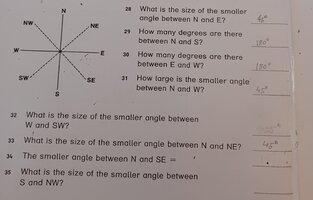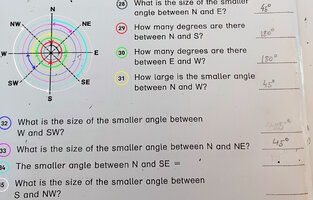LiseyDot05
New member
- Joined
- May 3, 2023
- Messages
- 35
Afternoon everyone. Looking for a wee bit of confirmation that O is on the right track. He divided 360° by 8 and got 45° for each section.
He's hesitating over questions 31, 32, 33, 34 & 35.
Ignoring his current answers, because he has since realised his mistake, is he on the right track with the following?
31. 90°
32. 45°
33. 45°
34. 135°
35. 135°

He's hesitating over questions 31, 32, 33, 34 & 35.
Ignoring his current answers, because he has since realised his mistake, is he on the right track with the following?
31. 90°
32. 45°
33. 45°
34. 135°
35. 135°


